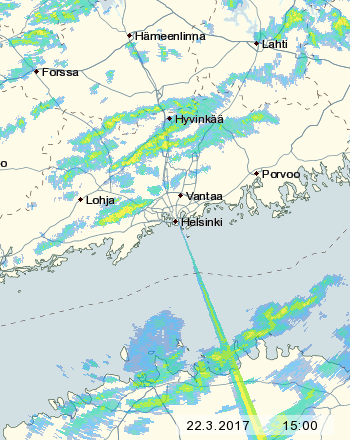European weather radars use frequencies between 5,60 and 5,65 GHz. In WiFi parlance it means channels 120, 124 and 128. If a WiFi device detects a radar signal it will either change channel or go silent for a half an hour. Either way the connection will be dropped. Your safest bet is to avoid these channels. On the other hand, there are just ten weather radars in Finland and they are pretty far apart. Do you need to avoid a channel in use in Utajärvi if you are in Helsinki? No. Usually it suffices to avoid the frequency used by the nearest radar.
Don’t be surprised when the WiFi doesn’t appear immediately. New and recently upgraded access points will listen for ten minutes for radar signals on these channels. This doesn’t sound good, but on the other hand these channels have least traffic for the very same reason.
Here is the current (3/2017) list of frequencies:
| Name |
Established |
Position |
Height |
Frequency |
WiFi Channel |
| Anjalankoski |
1994 |
60.9039N |
139 m |
5638 |
128 |
| Ikaalinen |
1994 |
61.7673 N |
153 m |
5644 |
128 |
| Kesälahti |
2014 |
61.9070N |
174 m |
5610 |
124 |
| Korppoo |
1997 |
60.1285N |
61 m |
5620 |
124 |
| Kuopio |
1995 |
62.8626N |
268 m |
5615 |
124 |
| Luosto |
2000 |
67.1391N |
533 m |
5618 |
124 |
| Petäjävesi |
2015 |
62.3045N |
271 m |
5628 |
124 |
| Utajärvi |
1997 |
64.7749N |
118 m |
5608 |
120 |
| Vantaa |
1994 |
60.2706N |
82 m |
5649 |
128 |
| Vimpeli |
2005 |
63.1048N |
200 m |
5639 |
128 |
This is an example of radar interference. The narrow, straight patch of ”rain” between Helsinki and Tallinn is a caused by a transmitter on channel 128. The transmitter is either in Tallinn or on the sea, because the the beam is so narrow. A transmitter closer by would cause a wider sector of interference.


Next time I am in Helsinki Lets talk.
Where is your CWNE Certifiation? 🙂
I’d be glad to! Just drop me an email before you arrive: petri.riihikallio@metis.fi
I haven’t applied yet. I’d need some endorsers but I don’t know any CWNEs. They are quite hard to find here in Finland…